Deleted Member 60978
Well-known member
- Joined
- Feb 16, 2025
- Messages
- 299
- Reputation
- 552
After much debate on whether I should do this thread or not, I have decided that I will do it, honestly the greycels and 99% of the forum will never do this method but if someone is low enough inhib and has little to lose this could help them to have an ascension.
First I would like to clarify the importance of the sphenoid bone in facial development. This topic has already been discussed in a previous thread, but I will include it in this thread as well: https://forum.looksmaxxing.com/threads/sphenoid-bone-alignment-is-everything.31020/
"IMPORTANCE OF THE SPHENOID BONE"
The Sphenoid Bone Is the FOUNDATION of almost all maxillofacial problems. For it Is the area that the bones in your face emerge from.
And IMPROPER ENVIRONMENT not BAD GENETICS, is the reason many modern humans lack proper sphenoid allignment.
Here is an interesting study I found that looked at the relation to poor posture to malloclusion.
 pmc.ncbi.nlm.nih.gov
pmc.ncbi.nlm.nih.gov
In the study it is stated that:
"There was a statistically significant correlation between presence of kyphotic posture and a reduction in the SNB angle, representing sagittal position of the mandible. Also, there was a statistically significant association between kyphotic posture and nasopharyngeal obstruction"
The most important takeaway is that It found that poor (kyphotic) posture, had a significant correlation with obstruction of the nasopharynx.
To understand why this is so important, I'll ask you to refer to this image.
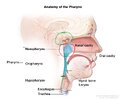
The red area is the nasopharynx and the green area is the sphenoid. Notice how close they are together?
Now look at the following gif, look at how as the sphenoid bone alligns properly, the nasopharynx becomes LESS obstructed.
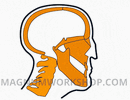
To put it simply, without the study even mentioning it. It demonstrated that SHIT POSTURE BREEDS SHIT SPHENOID ALLIGNMENT, which also inadvertently makes everything else about your face develop improperly. (mallocusion, sleep apnea etc..)
It should start to make a bit more sense now. EVERYTHING IN YOUR SKULL IS CONNECTED TO THE SPHENOID, and the fact that modern orthodontistry only addresses these problems on a surface level instead of a holistic approach.
How the sphenoid relates to the maxilla (Expansion and forward growth):
Relationship of the Sphenoid to the Maxilla: Expansion and Projection
The sphenoid bone plays a CRUCIAL ROLE in the structure and position of the maxilla. It connects directly to the maxilla via the sphenopalatine suture (the red area), meaning that any change in its position can influence the shape and development of the maxilla/midface.
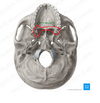
When the sphenoid is in an unfavorable position (e.g. tilted or compressed), it can RESTRICT MAXILLA GROWTH in two directions:
Laterally, by limiting palatal expansion.
Forward, by preventing optimal maxilla projection.
In my previous thread, I detailed my palatal expansion plan to improve my facial structure and dental alignment. However, to maximize these results, correcting the position of the sphenoid is also key.
A correctly positioned sphenoid will facilitate maxillary expansion by reducing resistance from the skull base, allowing the maxilla to widen more easily. But most importantly, it can also unlock the anteroposterior projection of the maxilla, which has a direct impact on facial aesthetics by:
Improving the prominence of the midface.
Highlighting the cheekbones and facial bone structure.
Optimizing the relationship between the maxilla and the mandible for better occlusion. (Lifefuel for fucked up bitecels)
Craneal release:
So if I do an NCR and most of the bones are connected to the face, will I be able to release most of my cranial sutures?
Yes, basically, doing NCR is like use WD-40 in the rusty screws of a structure so everything can move better. Since the sphenoid is in the center of the skull and articulates with a bunch of facial bones, when you tighten it, you unlock a knock-on effect on a lot of other sutures. And if the sutures are less stiff, the bones of the face can move and accommodate better, which is key to looksmaxxing.
What happens if you release these sutures?
Each one affects facial aesthetics in a different way:
Sphenopalatine Suture → Easier maxillary expansion
Median Palatal Suture → Optimized maxillary expansion
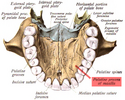
Sphenooccipital Suture → Better posture and better jaw support
Sphenotemporal Suture → Better aligned and more symmetrical jaw.
Sphenofrontal Suture → More aligned eyes and better facial symmetry
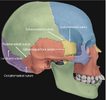
What is NCR? NCR is a powerful technique to loosen the bones and sutures in your face, as well as releases connective tissues to unwind the body and return it to it’s original design. It first started back in the 90s as a specific form of Bilateral Nasal Specific (BNS), which BNS was used back in the 1930s. So as you can see its been around for a while.
What exactly is NCR though? NCR is basically were you inflate a balloon in your skull. Sounds crazy I know but it is actually a medical practice.
What are the benefits of NCR?
NCR successfully improves many conditions including:
· Anxiety
· Attention Deficit Disorder; poor concentration and focus; dyslexia, hyperactivity and other learning disabilities; autism
· Depression
· Cerebral palsy; down's syndrome
· Concussion and other head injuries; brain surgery
· Dystonia
· Ear infection, acute & chronic, & deafness; tinnitus
· Glaucoma; double vision; other vision problems
· Headaches, head pressure and migraines
· Low energy (fibromyalgia, chronic fatigue)
· TMD or TMJ (Mouth, head and jaw pains)
· Multiple sclerosis
· Muscular dystrophy
· Muscle spasms; neck and shoulder pain
· Orthodontic stress and bruxism (grinding)
· Parkinson's disease and tremors
· Sciatica; kyphosis (hunchback); lordosis (swayback); scoliosis (a spiral spine); military spine (from whiplash) and other back problems
· Seizures
· Sinusitis; sleep apnea; snoring; breathing and sinus disorders
· Strokes; thrombosis (excessive blood clotting)
· Vertigo and other balance problems
and lastly improved symmetry and cranial facial structure
How does NCR work?
NCR when done by a professional usually lasts 4 days with 1 hour treatment everyday and done once a month. It firsts starts off with a massage on the patient to open up the spine and allow skeletal alignment. Than the doctor analyzes the body’s pattern of balance to see which spots of the skull should be unlocked. Next the doctor inserts endonasal balloons through the nostril into the top of the throat through one of the six nasal passageways. The inflating bulb is squeezed, pumping air into the balloon and puffing up the nostril. Air pressure in the balloon increases, pressing outward against the bones inside the nose and upper throat. The pressure eventually pushes the balloon into the top of the throat and the bony joints of the head briefly open, releasing tensions stored in the connective tissues. The bone structures of the head now shift. So it basically release tension in the sphenoid bone and in the skull and helps it to become more loose and to be able to move more freely. But most of you know that pressure causes the sutures and bones to tighten. Yes this is true, but the amount of force causes their to be such a build in pressure that the pressure “breaks” and the bones become looser than ever before. The reason why some people get negative results is they don’t apply enough pressure and it just makes the school tighter (more on this later).
Here is a similar explanation from someone else:
“Here's the best way to understand it: the connective tissues (dura mater) hold the skull in place, and as skull is impacted in minor ways over time, these impacts "scrunch" the connective tissue pulling the skull plates with it. Over the course of various traumas the connective tissue becomes more and more scrunched and tense. Obviously there needs to be some kind of intervention to loosen the tissue and let it retake its original shape, but how? By nudging the sphenoid, apparently. When the sphenoid moves (less than .5mm), 20 other bones are "pushed" or "pulled" about ever so slightly. As the balloon is inflated, the sphenoid resists, tension builds in the skull, then comes the release. If you were to imagine it in numbers, let's say your connective tissue tension level starts at 75. With each inflation of the balloon against the sphenoid, tension movesup to 76, 77, 78 as the sphenoid resists, then suddenly gives slightly and releases back down to 73. This is why when people don't use enough force and don't get a proper amount of release, but instead just built more tension in the connective tissue, they get bad results or negative results. The wonderful thing about all of this is that tension in the connective tissue correlates directly with bone symmetry, cerebrospinal fluid flow and other important processes. As the connective tissuesdrop tension, the face becomes more beautiful and natural the way it would be without nutritional, emotional, genetic and physical trauma.”
How do I find a professional for NCR?
I would recommend you to search online and try to find one near you. But for many of you if not all, your not going to find one anywhere close to you, so that is were at home NCR comes into play. (Also not to mention its like 500 dollars per session and I know y’all some broke mofos)
Self NCR, the Basics:
First lets talk about the risks of Self NCR
To summarize: Use enough force when squeezing the bulb to feel expansion throughout one side of your face and into the other side. Once you feel expansion throughout your whole face, stop inflating. If you've already inflated 5 times or more than 20 seconds and have felt no expansion, stop and move to a different nasal passage.
You can buy all of this on amazon
Here is one fully constructed:
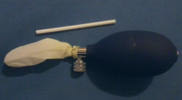
Make sure to wrap the dental floss 20-30x around so it doesn’t explode in your mouth, its also important to hold your breath during the treatment to lower any chances of inhaling the balloon. Make sure to replace your finger cot every 3-4 treatments.
Many people don’t release that they are doing the treatment wrong at the begging. Most people inflate in the nasal turbinate's instead of the open space behind them.
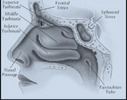
Notice in the illustration above the three "holes" between the turbinate's. These are the nasal passages. There are three passages in each nostril. The goal is to insert the balloon through the passage so that most of the balloon is resting just behind the turbinate and into the upper throat (near the sphenoid bone, that white bone surrounding the sphenoid sinus in the above illustration). The best way to get the balloon through the nasal passage is to use the blunt end of a toothpick and a lubricated balloon (finger cot with water). To reach the top passage, insert the balloon while pushing it up against the top wall of the nose. To reach the bottom passage, insert the balloon while pushing it against the bottom wall of the nose. To get the balloon resting behind a nasal passage and into the throat, squeeze the bulb slowly, gently, and fully while pushing and making slight twists. This will ensure the balloon is straightened and in place. Once it's behind a nasal passage and in the throat you will feel it reach "open air." If the finger cot balloon is too large, it can possibly come down into the throat and gag you when inflated. If it's too small you won't be able to get it all the way through the nasal passage.
This is what I do: stand up in front of a mirror, making full pumps (squeezing out all the air) in succession, 3-4 times, pump in rapid succession. Never pump more than 5 times in one nasal passage, especially if you get no movement/expansion/release. During inflation, always hold the breath to ensure the balloon wont be inhaled. If there's a sudden pressure differential (release of pressure in the throat) and a feeling of movement/expansion through one side of the face then the next, immediately deflate the balloon and withdraw it from the nasal passage. Usually I'll feel the expansion through one side of my face after 13 inflations, then on the 3rd4th inflation I'll feel it in the other side of my face>through to the ear. When the expansion has gone through both sides of the face, stop. Some people think they're supposed to hear a cracking sound or feel something phenomenal but this probably won't happen all at once unless a lot of force is used (not recommended). The NCR specialists use a ton of force and treat only four times a month in order to maximize each treatment. It’s better to treat yourself 12-15 times gently and without all the massage.
Asymmetrical Method (TL ML BL or TR MR BR)
Asymmetrical = top left, middle left, bottom left the first day... top right, middle right, bottom right the second day, etc. Some people also study their face closely, and treat asymmetrically on the weakest side. So for example if the left side is more narrow than the right side, they would treat the left side until it's even with the right. This actually does work although the NCR doctors are told it's unreliable (probably having to do with promoting and controlling the techniques involved in NCR). Dr. Howell invented proprioceptive testing, which supposedly allows the NCR practitioner to determine the "most unstable" part of the physical structure to correct, corresponding to an area of the sphenoid. I still haven't determined whether this is true or not. It seems there are more effective placements and less effective placements, but it's not all or nothing as NCR practitioners claim. This method is not available to me or anyone else, as it takes a while to learn. This is primarily what sets NCR apart from BNS and other balloon based cranial therapies.
Intuitive Placement Method
The method that works the best for the most people is intuitive placement. If one side of the face is particularly asymmetrical or narrow, you may want to treat on that side (because you'll get greater expansion on the side of the face that you're treating). You can use these kinds of assessments to decide the best place for the balloon, and oftentimes this means going in the same nasal passage over and over. There's nothing wrong with that, but you may want to experiment and try other passages just to get a better sense over time for the best placement. In either case if you're treating the left side or right side, or upper passage or lower passage, bones throughout the face and head will change position (especially in the beginning)
I treat between 2pm and 8pm assuming a normal day/night schedule, and no later than 8pm (earlier than 2pm is okay). Treating too early in the morning can be risky as you get tired, whereas too late in the day might make you too energized to sleep. Also, doctors advise 20 minutes of walking per day at minimum (POST treatment) to facilitate and stimulate the unwinding process. I agree. As for the question of "how often?" Dr. Howell writes, He goes on to say that the patient who underwent 24 treatments in one month had excellent results, but a lot more cranial sensitivity ("movement" aka unwinding sensations in the skull/body). I stick with 10-15 times (days) per month. It only takes a minute or two each day.
People need to be in the right mindset when it comes to healing at such a fundamental, structural level. The body will not change if it isn't ready to change. These therapies are essentially about undoing, allowing the body to reset to it's ideal, normal position. The body will hold its current unhealthy structure and 'wind back up' after treatment if it isn't given what it needs to unwind. Getting on a good diet, avoiding sugar and wheat, sticking to a regular exercise routine, stretching and yoga are extremely helpful strategies recommended by all practitioners.
Thanks Ben for your protocol.
Results in posture:


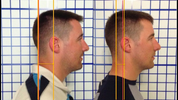
@DoctorDurden @geneticCage @neymar @Dean @Nihilus @AverageMoroccan @Milk @lowkeydeadinside @BimaxLaser @Chifuyu @huntergirl @N30N
First I would like to clarify the importance of the sphenoid bone in facial development. This topic has already been discussed in a previous thread, but I will include it in this thread as well: https://forum.looksmaxxing.com/threads/sphenoid-bone-alignment-is-everything.31020/
"IMPORTANCE OF THE SPHENOID BONE"
The Sphenoid Bone Is the FOUNDATION of almost all maxillofacial problems. For it Is the area that the bones in your face emerge from.
And IMPROPER ENVIRONMENT not BAD GENETICS, is the reason many modern humans lack proper sphenoid allignment.
Here is an interesting study I found that looked at the relation to poor posture to malloclusion.
Relationships between Malocclusion, Body Posture, and Nasopharyngeal Pathology in Pre-Orthodontic Children - PMC
Malocclusion, body posture, and breathing pattern may be correlated, but this issue is still controversial. The aim of the study was to examine the relationship between the type of malocclusion, body posture, and nasopharyngeal obstruction in ...
In the study it is stated that:
"There was a statistically significant correlation between presence of kyphotic posture and a reduction in the SNB angle, representing sagittal position of the mandible. Also, there was a statistically significant association between kyphotic posture and nasopharyngeal obstruction"
The most important takeaway is that It found that poor (kyphotic) posture, had a significant correlation with obstruction of the nasopharynx.
To understand why this is so important, I'll ask you to refer to this image.

The red area is the nasopharynx and the green area is the sphenoid. Notice how close they are together?
Now look at the following gif, look at how as the sphenoid bone alligns properly, the nasopharynx becomes LESS obstructed.

To put it simply, without the study even mentioning it. It demonstrated that SHIT POSTURE BREEDS SHIT SPHENOID ALLIGNMENT, which also inadvertently makes everything else about your face develop improperly. (mallocusion, sleep apnea etc..)
It should start to make a bit more sense now. EVERYTHING IN YOUR SKULL IS CONNECTED TO THE SPHENOID, and the fact that modern orthodontistry only addresses these problems on a surface level instead of a holistic approach.
How the sphenoid relates to the maxilla (Expansion and forward growth):
Relationship of the Sphenoid to the Maxilla: Expansion and Projection
The sphenoid bone plays a CRUCIAL ROLE in the structure and position of the maxilla. It connects directly to the maxilla via the sphenopalatine suture (the red area), meaning that any change in its position can influence the shape and development of the maxilla/midface.

When the sphenoid is in an unfavorable position (e.g. tilted or compressed), it can RESTRICT MAXILLA GROWTH in two directions:
Laterally, by limiting palatal expansion.
Forward, by preventing optimal maxilla projection.
In my previous thread, I detailed my palatal expansion plan to improve my facial structure and dental alignment. However, to maximize these results, correcting the position of the sphenoid is also key.
A correctly positioned sphenoid will facilitate maxillary expansion by reducing resistance from the skull base, allowing the maxilla to widen more easily. But most importantly, it can also unlock the anteroposterior projection of the maxilla, which has a direct impact on facial aesthetics by:
Improving the prominence of the midface.
Highlighting the cheekbones and facial bone structure.
Optimizing the relationship between the maxilla and the mandible for better occlusion. (Lifefuel for fucked up bitecels)
After researching for a while on palatal expansion and its impact on facial aesthetics, I decided to follow a progressive approach to obtain maximum improvement in both transverse (width-wise) and sagittal (forward) maxillary skeletal expansion. I am sharing my plan for feedback, critique, and to perhaps help others who are considering something similar. The plan is divided into three appliances:
Step 1: Rapid Expansion with RPE (Rapid Palatal Expander)
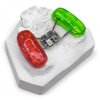
I will start with an RPE, which is a rapid palatal expander. This type of expander opens the palatal suture...
Step 1: Rapid Expansion with RPE (Rapid Palatal Expander)

I will start with an RPE, which is a rapid palatal expander. This type of expander opens the palatal suture...
- Deleted Member 60978
- Replies: 7
- Forum: Mewing
Craneal release:
So if I do an NCR and most of the bones are connected to the face, will I be able to release most of my cranial sutures?
Yes, basically, doing NCR is like use WD-40 in the rusty screws of a structure so everything can move better. Since the sphenoid is in the center of the skull and articulates with a bunch of facial bones, when you tighten it, you unlock a knock-on effect on a lot of other sutures. And if the sutures are less stiff, the bones of the face can move and accommodate better, which is key to looksmaxxing.
What happens if you release these sutures?
Each one affects facial aesthetics in a different way:
Sphenopalatine Suture → Easier maxillary expansion
Median Palatal Suture → Optimized maxillary expansion

Sphenooccipital Suture → Better posture and better jaw support
Sphenotemporal Suture → Better aligned and more symmetrical jaw.
Sphenofrontal Suture → More aligned eyes and better facial symmetry

NCR guide:
NCR (Neuro Cranial Restructuring)
What is NCR? NCR is a powerful technique to loosen the bones and sutures in your face, as well as releases connective tissues to unwind the body and return it to it’s original design. It first started back in the 90s as a specific form of Bilateral Nasal Specific (BNS), which BNS was used back in the 1930s. So as you can see its been around for a while.
What exactly is NCR though? NCR is basically were you inflate a balloon in your skull. Sounds crazy I know but it is actually a medical practice.
What are the benefits of NCR?
NCR successfully improves many conditions including:
· Anxiety
· Attention Deficit Disorder; poor concentration and focus; dyslexia, hyperactivity and other learning disabilities; autism
· Depression
· Cerebral palsy; down's syndrome
· Concussion and other head injuries; brain surgery
· Dystonia
· Ear infection, acute & chronic, & deafness; tinnitus
· Glaucoma; double vision; other vision problems
· Headaches, head pressure and migraines
· Low energy (fibromyalgia, chronic fatigue)
· TMD or TMJ (Mouth, head and jaw pains)
· Multiple sclerosis
· Muscular dystrophy
· Muscle spasms; neck and shoulder pain
· Orthodontic stress and bruxism (grinding)
· Parkinson's disease and tremors
· Sciatica; kyphosis (hunchback); lordosis (swayback); scoliosis (a spiral spine); military spine (from whiplash) and other back problems
· Seizures
· Sinusitis; sleep apnea; snoring; breathing and sinus disorders
· Strokes; thrombosis (excessive blood clotting)
· Vertigo and other balance problems
and lastly improved symmetry and cranial facial structure
How does NCR work?
NCR when done by a professional usually lasts 4 days with 1 hour treatment everyday and done once a month. It firsts starts off with a massage on the patient to open up the spine and allow skeletal alignment. Than the doctor analyzes the body’s pattern of balance to see which spots of the skull should be unlocked. Next the doctor inserts endonasal balloons through the nostril into the top of the throat through one of the six nasal passageways. The inflating bulb is squeezed, pumping air into the balloon and puffing up the nostril. Air pressure in the balloon increases, pressing outward against the bones inside the nose and upper throat. The pressure eventually pushes the balloon into the top of the throat and the bony joints of the head briefly open, releasing tensions stored in the connective tissues. The bone structures of the head now shift. So it basically release tension in the sphenoid bone and in the skull and helps it to become more loose and to be able to move more freely. But most of you know that pressure causes the sutures and bones to tighten. Yes this is true, but the amount of force causes their to be such a build in pressure that the pressure “breaks” and the bones become looser than ever before. The reason why some people get negative results is they don’t apply enough pressure and it just makes the school tighter (more on this later).
Here is a similar explanation from someone else:
“Here's the best way to understand it: the connective tissues (dura mater) hold the skull in place, and as skull is impacted in minor ways over time, these impacts "scrunch" the connective tissue pulling the skull plates with it. Over the course of various traumas the connective tissue becomes more and more scrunched and tense. Obviously there needs to be some kind of intervention to loosen the tissue and let it retake its original shape, but how? By nudging the sphenoid, apparently. When the sphenoid moves (less than .5mm), 20 other bones are "pushed" or "pulled" about ever so slightly. As the balloon is inflated, the sphenoid resists, tension builds in the skull, then comes the release. If you were to imagine it in numbers, let's say your connective tissue tension level starts at 75. With each inflation of the balloon against the sphenoid, tension movesup to 76, 77, 78 as the sphenoid resists, then suddenly gives slightly and releases back down to 73. This is why when people don't use enough force and don't get a proper amount of release, but instead just built more tension in the connective tissue, they get bad results or negative results. The wonderful thing about all of this is that tension in the connective tissue correlates directly with bone symmetry, cerebrospinal fluid flow and other important processes. As the connective tissuesdrop tension, the face becomes more beautiful and natural the way it would be without nutritional, emotional, genetic and physical trauma.”
How do I find a professional for NCR?
I would recommend you to search online and try to find one near you. But for many of you if not all, your not going to find one anywhere close to you, so that is were at home NCR comes into play. (Also not to mention its like 500 dollars per session and I know y’all some broke mofos)
Self NCR, the Basics:
First lets talk about the risks of Self NCR
- Bone Fracture (You have to use a insane amount of force, like a crazy amount, trust me this won’t happen)
- Inhaling the balloon (Just follow the steps ahead and this won’t happen)
- Regression in symmetry and facial structure (This happens from not using enough pressure and not being consistent)
To summarize: Use enough force when squeezing the bulb to feel expansion throughout one side of your face and into the other side. Once you feel expansion throughout your whole face, stop inflating. If you've already inflated 5 times or more than 20 seconds and have felt no expansion, stop and move to a different nasal passage.
How to make your device:

Here is the equipment I use- Sphygmomanometer bulb with release valve
- Finger cots (large)
- Dental floss (waxed)
- Flat tooth picks
You can buy all of this on amazon
Here is one fully constructed:

Make sure to wrap the dental floss 20-30x around so it doesn’t explode in your mouth, its also important to hold your breath during the treatment to lower any chances of inhaling the balloon. Make sure to replace your finger cot every 3-4 treatments.
Locating the Sphenoid Bone
Many people don’t release that they are doing the treatment wrong at the begging. Most people inflate in the nasal turbinate's instead of the open space behind them.

Notice in the illustration above the three "holes" between the turbinate's. These are the nasal passages. There are three passages in each nostril. The goal is to insert the balloon through the passage so that most of the balloon is resting just behind the turbinate and into the upper throat (near the sphenoid bone, that white bone surrounding the sphenoid sinus in the above illustration). The best way to get the balloon through the nasal passage is to use the blunt end of a toothpick and a lubricated balloon (finger cot with water). To reach the top passage, insert the balloon while pushing it up against the top wall of the nose. To reach the bottom passage, insert the balloon while pushing it against the bottom wall of the nose. To get the balloon resting behind a nasal passage and into the throat, squeeze the bulb slowly, gently, and fully while pushing and making slight twists. This will ensure the balloon is straightened and in place. Once it's behind a nasal passage and in the throat you will feel it reach "open air." If the finger cot balloon is too large, it can possibly come down into the throat and gag you when inflated. If it's too small you won't be able to get it all the way through the nasal passage.
Inflating the Balloon:
This is what I do: stand up in front of a mirror, making full pumps (squeezing out all the air) in succession, 3-4 times, pump in rapid succession. Never pump more than 5 times in one nasal passage, especially if you get no movement/expansion/release. During inflation, always hold the breath to ensure the balloon wont be inhaled. If there's a sudden pressure differential (release of pressure in the throat) and a feeling of movement/expansion through one side of the face then the next, immediately deflate the balloon and withdraw it from the nasal passage. Usually I'll feel the expansion through one side of my face after 13 inflations, then on the 3rd4th inflation I'll feel it in the other side of my face>through to the ear. When the expansion has gone through both sides of the face, stop. Some people think they're supposed to hear a cracking sound or feel something phenomenal but this probably won't happen all at once unless a lot of force is used (not recommended). The NCR specialists use a ton of force and treat only four times a month in order to maximize each treatment. It’s better to treat yourself 12-15 times gently and without all the massage.
Best Patterns:
Asymmetrical Method (TL ML BL or TR MR BR)
Asymmetrical = top left, middle left, bottom left the first day... top right, middle right, bottom right the second day, etc. Some people also study their face closely, and treat asymmetrically on the weakest side. So for example if the left side is more narrow than the right side, they would treat the left side until it's even with the right. This actually does work although the NCR doctors are told it's unreliable (probably having to do with promoting and controlling the techniques involved in NCR). Dr. Howell invented proprioceptive testing, which supposedly allows the NCR practitioner to determine the "most unstable" part of the physical structure to correct, corresponding to an area of the sphenoid. I still haven't determined whether this is true or not. It seems there are more effective placements and less effective placements, but it's not all or nothing as NCR practitioners claim. This method is not available to me or anyone else, as it takes a while to learn. This is primarily what sets NCR apart from BNS and other balloon based cranial therapies.
Intuitive Placement Method
The method that works the best for the most people is intuitive placement. If one side of the face is particularly asymmetrical or narrow, you may want to treat on that side (because you'll get greater expansion on the side of the face that you're treating). You can use these kinds of assessments to decide the best place for the balloon, and oftentimes this means going in the same nasal passage over and over. There's nothing wrong with that, but you may want to experiment and try other passages just to get a better sense over time for the best placement. In either case if you're treating the left side or right side, or upper passage or lower passage, bones throughout the face and head will change position (especially in the beginning)
When and how often?
I treat between 2pm and 8pm assuming a normal day/night schedule, and no later than 8pm (earlier than 2pm is okay). Treating too early in the morning can be risky as you get tired, whereas too late in the day might make you too energized to sleep. Also, doctors advise 20 minutes of walking per day at minimum (POST treatment) to facilitate and stimulate the unwinding process. I agree. As for the question of "how often?" Dr. Howell writes, He goes on to say that the patient who underwent 24 treatments in one month had excellent results, but a lot more cranial sensitivity ("movement" aka unwinding sensations in the skull/body). I stick with 10-15 times (days) per month. It only takes a minute or two each day.
Achieving Maximum Results:
People need to be in the right mindset when it comes to healing at such a fundamental, structural level. The body will not change if it isn't ready to change. These therapies are essentially about undoing, allowing the body to reset to it's ideal, normal position. The body will hold its current unhealthy structure and 'wind back up' after treatment if it isn't given what it needs to unwind. Getting on a good diet, avoiding sugar and wheat, sticking to a regular exercise routine, stretching and yoga are extremely helpful strategies recommended by all practitioners.
Thanks Ben for your protocol.
Results in posture:



@DoctorDurden @geneticCage @neymar @Dean @Nihilus @AverageMoroccan @Milk @lowkeydeadinside @BimaxLaser @Chifuyu @huntergirl @N30N
Last edited:





